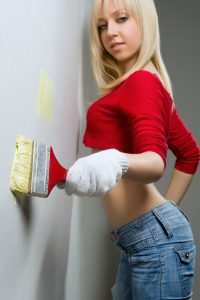Preparing, Working & Finishing Your Decorating Chores

Whether you are simply painting a wall, are wallpapering an awkward space or have chosen to completely revamp a damaged wall it is important to get advice if you want to do it properly. Whilst there is always the DIY option, it is not always the easiest – or the cheapest – due to the tools, preparation, choices of décor and potential damage that can occur whilst you undertake your project. That said, many people choose to take the time to conduct the painting and decoration to a high standard.
Tools
There is a checklist and a multitude of tools to consider when you are painting, and more if you have chosen to wallpaper too.
If you are freshening up just one wall, or painting an entire tired space, you will cheer up the mood of that room once you have finished but you need to think about the tools required to do the job. Getting started is the hard work but carrying out your painting is for lots of people extremely therapeutic.
You will at the very minimum need to consider the following:
Dust Cloths – You will require these to protect furniture that either can’t be moved or that has to remain in the centre of the room. You will be surprised at just how dusty and messy painting can be. To avoid drips of paint on the floor you may wish to lay an entire cloth or plastic sheet and tape it down so that there are no gaps.
Screwdriver – Yes, a screwdriver. You may be amazed how often you will use one. To achieve a professional finish you will need to remove light fittings, sockets and shelves instead of painting around them – a no no in the painting and decorating world.
Patcher / Filler – Paint is not designed to fill cracks and holes and why paint the whole wall to find that the damage is still visible? Fill cracks carefully using a smooth knife and sandpaper when its dry to ensure they don’t show up when you have finished. The main issue here is to contact a professional plasterer if the cracks are large or the walls are flaky as it will be difficult to fill these in will general patching materials.
Water, Bucket, Dry Cloth & Sponge – It’s vital to clean walls and dry them before you begin. Anywhere that is high traffic or is touched often, or attracts grease and moisture, needs to be cleaned otherwise paint will not adhere to the wall or ceiling properly.
Decorators Tape – This is essential and will help you to protect any areas that you do not wish to paint, such as skirting. Although you will probably embark on painting the skirting or door frames, some people choose not too. It’s not a fool proof way to get straight lines though if you stick it down carefully it can help get razor sharp lines. Make sure you choose the right tape for the job – some tape won’t stick to skirting where some will stick too much to walls and ceilings, rendering your job rather difficult!
Roller & Tray – Make sure you have a tray as a roller makes the job much easier than simply using a brush. Different types of paint and different surfaces need a varying type of roller so ensure you choose the right type.
Summary
Click to get a free quote and to read more about a Essex Building Company that can do your painting and Decorating Painting your own space can be hugely rewarding; No matter how much time it takes, when you are finished it can look spectacular – but only if you have spent time preparing and choosing the right tools and materials for the job.
If you are in doubt about surface damage or simply would like to hire a professional painter and decorator, then we are ready to help our Essex and South East based customers to achieve the most perfect finish.